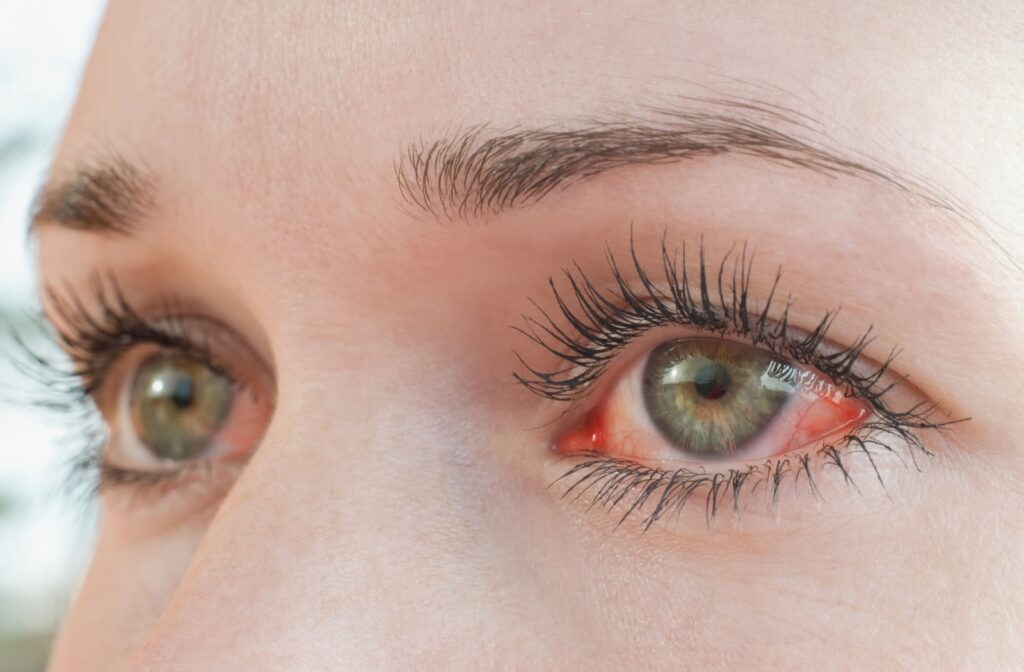Red, irritated eyes can be alarming—but not every red eye is pink eye. Because conjunctivitis shares symptoms like swelling, discharge, and discomfort with other conditions, it’s easy to misidentify what’s really going on without a comprehensive evaluation.
Conditions like allergies, dry eye disease, styes, blepharitis, and subconjunctival hemorrhages all mimic the signs of conjunctivitis. Each has a different cause and a different treatment—it’s important to find the care your eyes truly need.
Getting the Right Diagnosis for the Right Treatment
Pink eye shares symptoms—such as redness, swelling, discharge, and irritation—with several other eye conditions. These overlapping characteristics make it easy for an untrained eye to mistake conjunctivitis for something else, especially without a professional evaluation.
Incorrect assumptions can lead to improper treatment, which may worsen discomfort and delay recovery.
To accurately identify the condition and uncover the underlying cause of irritation, your eye doctor will perform a series of tests to assess your eye health, symptoms, and the severity of the issue.
Conditions That Look Like Pink Eye
When the surface of the eye appears red or irritated, it often takes on a pinkish hue—leading many people to assume it’s pink eye. Outside of the healthcare world, “pink eye” is often used as a catch-all term. However, it’s a distinct condition with its own set of symptoms.
There are several types of pink eye, each with different causes, slightly varied characteristics, and unique treatment approaches. On top of that, a number of eye conditions can mimic the symptoms of conjunctivitis. Below, we’ll explore some of the most common lookalikes.
Allergies
Also known as allergic conjunctivitis (yes—another form of pink eye), this condition occurs when the eyes react to allergens like pollen, dust, or pet dander. Your body’s immune response can lead to redness, itching, and watery eyes.
In addition to allergic conjunctivitis, there are also viral and bacterial forms of pink eye. These are highly contagious (which is why they often cause concern), while allergy-related pink eye is not contagious.
Key differences between allergies and non-allergic pink eye include:
- Itchiness: Allergies typically cause intense itching, while viral or bacterial conjunctivitis causes more soreness and burning.
- Additional symptoms: Sneezing, nasal congestion, and an itchy nose often accompany allergies.
- Eye involvement: Allergies usually affect both eyes at once, while viral or bacterial pink eye may start in one eye and spread to the other.
- Treatment approach: Eye allergies respond to antihistamines, artificial tears, and avoiding allergens—not antibiotics, which are used for bacterial conjunctivitis.
Blepharitis
Blepharitis is inflammation of the eyelids, often related to clogged oil glands at the base of the eyelashes. It can also be linked to bacteria, dandruff, or skin conditions like rosacea.
Key differences between blepharitis and pink eye include:
- Eyelid changes: Blepharitis often causes crusting or flaking around the eyelashes, which is not commonly seen with pink eye.
- Onset and duration: Blepharitis tends to be chronic, with symptoms that come and go. Pink eye usually develops more suddenly.
- Location of symptoms: Pink eye affects the conjunctiva (the clear membrane over the white of the eye), while blepharitis primarily impacts the eyelids.
Because blepharitis is often a long-term condition, it’s typically managed with daily eyelid hygiene, warm compress masks, and in-office treatments.
Dry Eyes
Dry eyes are a chronic condition that occurs when your eyes don’t produce enough tears or when tears evaporate too quickly. A disruption in the tear film—the thin layer that keeps your eyes lubricated—can also lead to dryness and discomfort.
Like conjunctivitis, dry eyes can cause redness, irritation, and a burning sensation. Factors such as prolonged screen use, improper contact lens wear and care, and environmental conditions can make symptoms worse.
Key differences between dry eyes and pink eye include:
- Dry eye symptoms are persistent, developing gradually rather than appearing suddenly.
- Discharge is uncommon with dry eyes, while conjunctivitis often produces discharge.
- Management differs: Dry eye is a long-term condition managed with ongoing care, while pink eye often resolves with time, antihistamines, or antibiotics, depending on the cause.
Dry eye is highly manageable. At-home remedies like warm compress masks and artificial tears can offer relief. For more severe or persistent symptoms, your eye doctor may recommend targeted in-office therapies.
Subconjunctival Hemorrhage
A subconjunctival hemorrhage occurs when a small blood vessel breaks beneath the eye’s clear surface, creating a noticeable bright red patch on the white of the eye.
While it can look alarming, this condition is usually harmless.
Although both pink eye and subconjunctival hemorrhages involve redness, the appearance is quite different. Subconjunctival hemorrhages result in a sharply defined, bright red blotch, while pink eye presents as diffuse redness across the eye’s surface.
Key differences between the two conditions include:
- A subconjunctival hemorrhage typically doesn’t involve discomfort, swelling, or discharge.
- It resolves on its own within several days to a few weeks, while pink eye usually requires active treatment.
Even though treatment isn’t required, it’s still a good idea to visit your optometrist so they can rule out any underlying issues.
Styes
A stye is a small, pus-filled bump that forms along the edge or inside of the eyelid. It’s caused by an infection in one of the eyelid’s oil glands. Like pink eye, styes can cause localized redness, swelling, and tenderness.
Key differences between styes and pink eye include:
- A stye is localized, often appearing as a distinct lump on the eyelid, whereas conjunctivitis causes more widespread swelling.
- Styes may produce tenderness to touch and visible crusting near the affected gland.
- While most styes resolve on their own with warm compresses, persistent or larger infections may require evaluation by your eye doctor.
Book Your Eye Exam for the Right Diagnosis
When it comes to eye health, an accurate diagnosis makes all the difference. If you’re experiencing symptoms like eye redness, discomfort, or discharge, don’t leave your care to guesswork. The team at McCauley Celin Eyecare Associates is here to help you get the right diagnosis and the right treatment. Book your eye exam today to get the clarity—and the care—you deserve.














